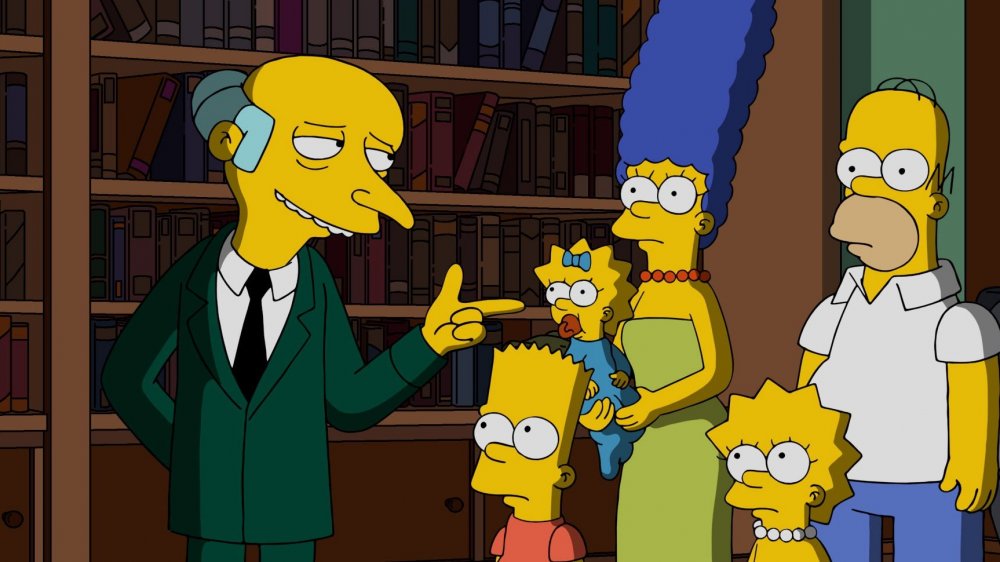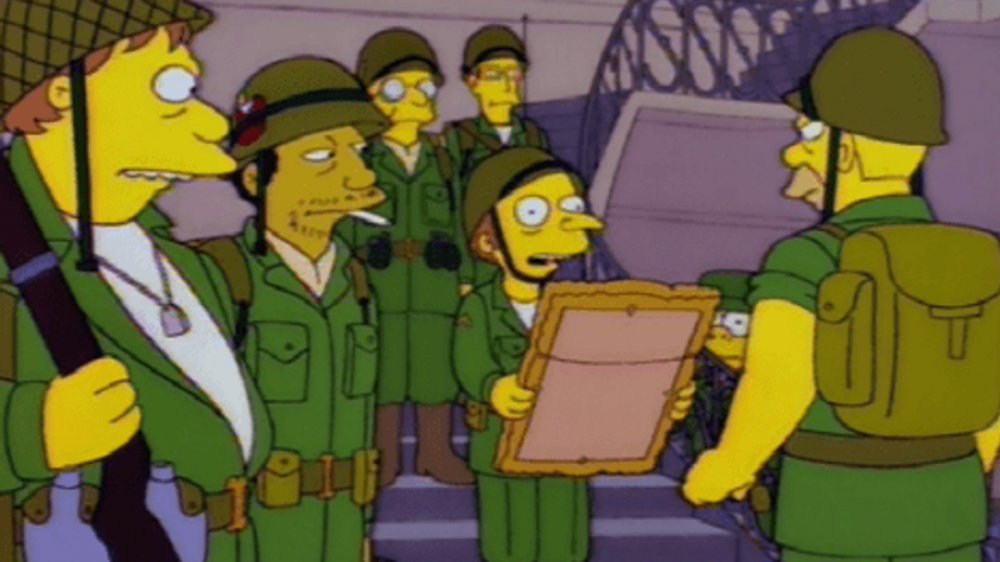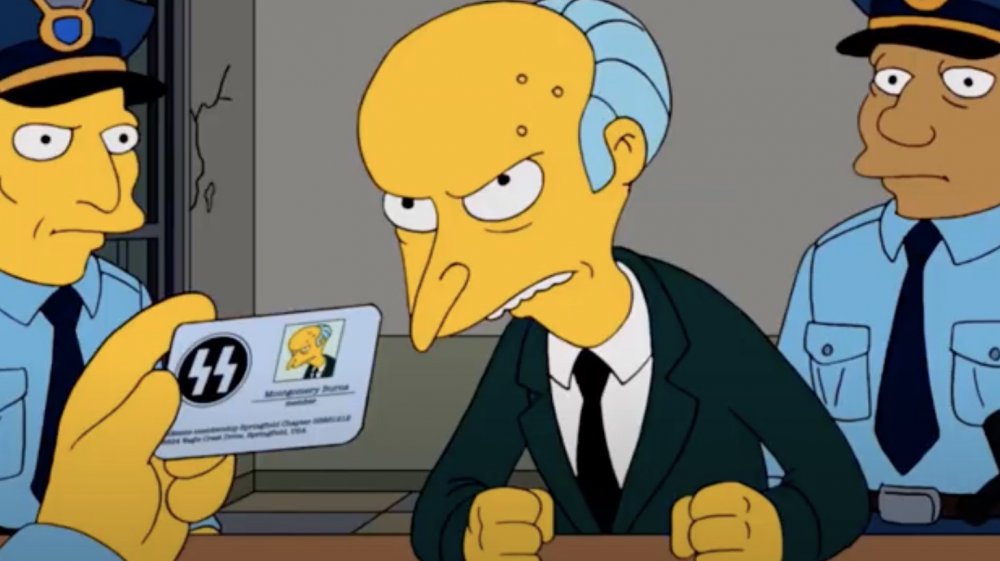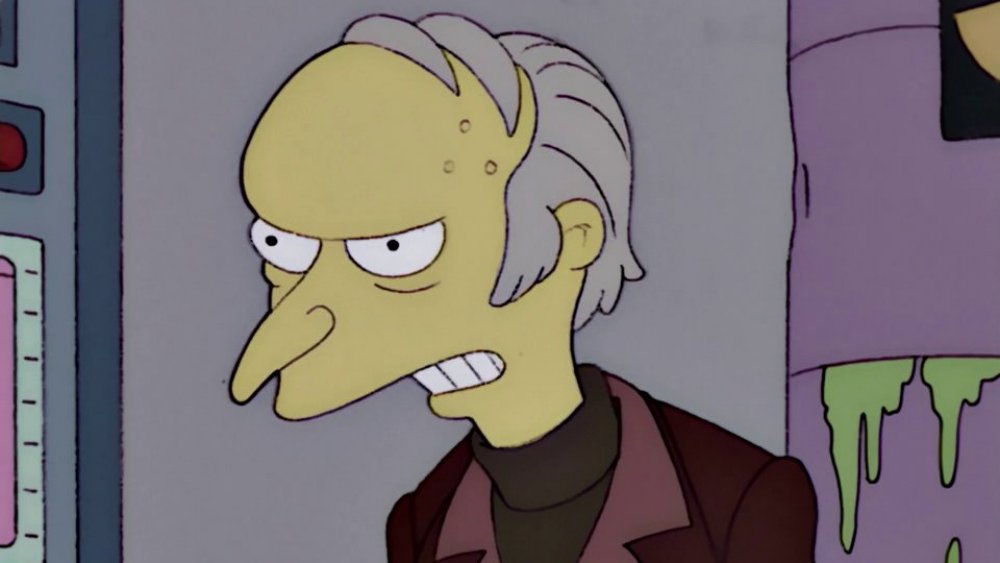Mr. Burns' Entire Simpsons Backstory Explained
C. Montgomery Burns — or Mr. Burns as he prefers and requires his underlings (which is everyone, as far as he's concerned) to call him — is one of the most loathsome and despicable characters ever created. And yet, the villain of The Simpsons is also one of most hilarious characters on the long-running series. Perhaps it's because of his ominous whisper of a voice (provided by Harry Shearer), or maybe it's the way he tents his fingers to chillingly proclaim some bit of wicked machination to be "excellent." But really, he's so funny because he's just so over the top and unabashedly evil and calculating. This is a man who once blocked out the sun and slaughtered endangered animals and dogs to make fancy clothes that he never wears.
It's fascinating just how one person could become so unspeakably cruel and proudly horrible. But why is Mr. Burns the way he is, with no morality or care for anyone or the world around him? Well, it's complicated. Here's the backstory of Mr. Burns explained.
Mr. Burns had a shocking childhood
C. Montgomery Burns once told a group of children at Springfield Elementary School that if they wished to succeed in business, they "must slay" the "three demons" of family, religion, and friendship. Mr. Burns indeed operates from a cutthroat, lone wolf, go-it-alone mindset. With the exception of his loyal assistant and biggest fan, Waylon Smithers, there isn't anyone he could call family.
However, at one point, Mr. Burns had ten older siblings, all of whom died in dark and awful ways. One was trampled by a horse, one got impaled on the Chrysler Building, and another was stabbed. On top of all that, Mr. Burns' twin sister was shot, another sibling spontaneously combusted, one fell down a well, and the rest consumed poisoned potatoes. The only children in the large family of Clifford and Daphne were the future Mr. Burns and his younger brother, George, as in legendary comedian George Burns.
As a boy, Mr. Burns went off to live with — and learn the ways of life from — his grandfather, Wainwright Montgomery Burns, an evil billionaire who ran the Springfield Atom Mill like a tyrant. And no, this didn't exactly help Mr. Burns become a fine, upstanding, caring citizen.
He's a Yale man
Mr. Burns is from old money, which carries with it a strong whiff of East Coast elitism. The man had every opportunity and advantage in life, including the chance to study at Yale University, one of the country's oldest and most prestigious universities. Burns has been depicted attending Yale football games, still dressing for them in the style that one would have in the early 20th century — wearing a fur coat and boater hat and clutching a pennant bearing the name of his team (with a deep animosity for rival Harvard in his heart).
While matriculating in New Haven, Connecticut, Burns studied science and business (prepping him for his career as proprietor of a nuclear power plant), joined the legendarily dark and powerful secret fraternal organization Skull and Bones, and also competed in sports. Apparently even in his youth, Burns was extremely slight of frame, as he competed in the "etherweight" wrestling class — not a real division but a nod to how he's so tiny that he weighs about as much as vapor. Burns successfully completed his education and graduated with the class of 1914.
Mr. Burns has been in love
He's emotionally distant and cares only about money and himself 99% of the time, but once in a while, Mr. Burns opens his heart to the notion of romance — or the least to the idea of having his physical needs as a man met.
While attending Yale University in the 1910s, he found a college sweetheart in the similarly wealthy and high-statused Mimsy Bancroft. But when he attended their 25-year college reunion feast in 1939, Burns discovered he had an interest in another Bancroft woman — Lily Bancroft, his old flame's 21-year-old blonde daughter, roughly two decades his junior. The two began a grand romance and found themselves unable to keep their strong urges at bay after hearing Clark Gable say the word "damn" in Gone with the Wind. They met up for a rendezvous in the Peabody Museum, getting intimate in the Inuit exhibit, after which Lily became pregnant. Seeking to avoid the scandal of their unwed daughter being with child, Lily's family forced her away to a convent in the South Seas, where she died, but not before giving up her baby for adoption. (That kid became Larry, a souvenir salesman voiced by Rodney Dangerfield, who'd meet his father around the age of 60.)
Mr. Burns' other major lady love from his younger days was his one-time fiancée Gertrude, who died of loneliness and rabies before they could wed.
He's incredibly old
The backstory of C. Montgomery Burns is likely more vast and detailed than even 30 years' worth of episodes of The Simpsons can express. That's because he's incredibly old. His antiquity is one of the show's most elaborate running gags, and put together, they make his exact vintage impossible and also contradictory. His birth year has been given as both 1881 and 1890, but he completed his undergraduate studies at Yale in 1914, putting his arrival around 1894. In "Last Exit to Springfield," Burns visits his grandfather's atom-smashing operation in 1909, and he appears to be about five or six years old. In "Simpson and Delilah," he states his age as 81, but in another installment, he's said to be 104. Then in "Fraudcast News," Burns says he's been 89 "for a while now," and yet when Springfield's oldest man dies at age 108 in "The Mansion Family," Burns becomes the newest oldest.
Burns might not even be in the triple digits, age-wise, but the quadruples. Before typing in his PIN on one occasion, he says it's his age ... then pecks out four numbers. He's also dropped references to his place of birth being Austria-Hungary and Pangea. The former was established in 1867 and collapsed after World War I, while the latter is the super-continent geologists say once comprised all land on Earth ... about 300 million years ago.
Mr. Burns fought for the U.S. in World War II
While most of U.S. troops in World War II were in their late teens and 20s, Mr. Burns also fought in the war, even though he was at least in his 40s at the time. After upsetting FBI director J. Edgar Hoover, Burns was assigned to the Flying Hellfish. Stationed in Europe and under the command of Master Sergeant Abraham Simpson, the battalion included several other Springfield residents, including Sheldon Skinner (Principal Skinner's father), Arnie Gumble (Barney's dad), and Nedwynn Flanders (Ned's granduncle).
Burns didn't take his job seriously and constantly caused trouble, such as messing up Abe Simpson's one and only chance to kill Adolf Hitler. Toward the end of the war, the Hellfish stormed a German castle, where Burns uncovered a cache of stolen artworks potentially worth millions. The group entered into a tontine, in which the last surviving member would get it all, which leads the extremely wealthy but still greedy Burns to try and kill his last living rival, Grampa Simpson, in the present day.
The two are evidently old rivals, and they also squared off during their mutual time in the U.S. Navy, also during World War II. In "Simpsons Christmas Stories," Grampa discusses the time he and Burns were stranded on a Pacific island together after their plane took enemy fire. While stuck there, Burns shot down Santa's magical sleigh, and then stole it in an attempt to get off the island.
Yeah ... Mr. Burns is a Nazi
Besides improbably fighting for two branches on opposite sides of the world during the same small period of time, Mr. Burns was heavily involved in the supply side of WWII. In a precursor to his days as a nuclear industrialist, he claims to have made weapons. In "A Star is Burns," Burns compares himself to Oskar Schindler, the subject of the film Schindler's List who saved the lives of 1,200 Jewish people by employing them in his wartime factory to make purposely nonfunctional bombs. However, Burns wasn't quite as noble as Schindler. "We both made shells for the Nazis," Burns says, "but mine worked."
Many seasons later, in the episode "American History X-cellent," Burns' involvement with the Nazis is confirmed. When he's arrested for being in possession of stolen Dutch masters, an SS membership card is discovered among his personal effects, meaning Burns was among the most elite and powerful of Hitler's henchmen. Despite being an avowed enemy of the United States, Burns was personally selected by President Harry Truman in 1945 to deliver a valuable and important $1 trillion bill to Europe after the war's conclusion to help pay for reconstruction. Of course, the money-obsessed Burns never handed it over.
He once ran a germ warfare lab
Long before he ever loomed and lorded over Springfield from the safety of his palatial office at the nuclear power plant, which the town counts on for its energy needs, Mr. Burns dealt in other potentially deadly and dangerous substances. In the 1960s, he headed up the Germ Warfare Laboratory, housed on the campus of Springfield University. It was there that Burns oversaw the exploitation of science for the use of deadly biological weapons. The facility's purpose was purely and expressly of a destructive nature, as evidenced by the slogan written above its doors, "When the H-Bomb Isn't Enough."
When Homer Simpson's mother, Mona Simpson, got caught up in the anti-war movement of the era, she helped six other hippies gain entry into Burns' lab and set off a bomb that killed all the noxious germs that lived inside. In the chaos of escaping, the group ran down Burns, with Mona turning back to see if he was alright. He showed his thanks by reporting her to the authorities, causing her to go on the lam for the rest of her life. After all, she killed his "precious germs."
Mr. Burns has been through a lot with the nuclear power plant
Mr. Burns eventually followed his grandfather into the atomic energy business. In the 2001 episode "The Blunder Years," 12-year-old Homer Simpson and friends Lenny and Carl have a wilderness campout next to where the Springfield Nuclear Power Planet "just opened." The fashions of the time (along with a Watergate allusion Mr. Burns makes in a quip about covering up crimes being "all the rage") suggest that it's the early 1970s. But while Homer, Lenny, and Carl will go on to work at the Power Plant years later, it almost kills them all right then and there, as the plant nearly experiences a core meltdown.
Luckily, the meltdown is stopped by Waylon Smithers Sr, who dies in the process. After his death, Burns takes pity on young Smithers Jr. and looks out for him. However, for decades, he keeps quiet the true circumstances of Smithers Sr.'s death, telling the boy he was killed by a tribe of "savage women" in the Amazon rainforest. By 1974, Burns has the plant up and running again.
Is Mr. Burns the devil?
C. Montgomery Burns is unabashedly wicked, treating everyone in his life poorly, up to and including his employees (even Smithers). But he could be far more than just a sour, bitter, self-centered old man — Mr. Burns just might be evil incarnate. For example, while filling out a patient information form for a doctor, Mr. Burns notes that his parents are deceased. Cause of death? They got in his way.
Need more proof that he's pure evil? Well, in the world of The Simpsons, the Springfield Republican Party is presented as a downright wicked organization, the political home of attempted murderer Sideshow Bob and the pistol-shooting Rich Texan, as well as Count Dracula. And who's the guy they picked to lead them? Party chairman C. Montgomery Burns.
The man even almost admits to being the actual prince of darkness. He goes out on a fancy date with Jacqueline Bouvier (Marge Simpson's mother), who responds to Burns' playful charm with, "I swear, Monty, you are the devil himself!" He momentarily flies into a dark rage, demanding to know, "Who told you?"









